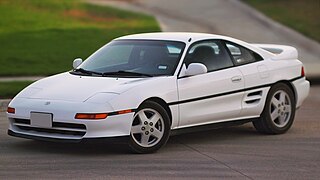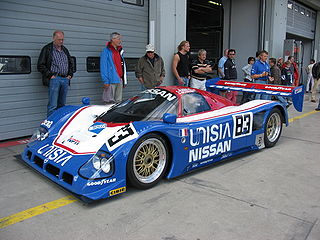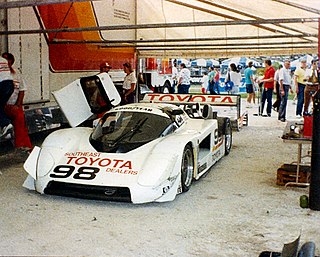Related Research Articles

Sports car racing is a form of motorsport road racing which utilises sports cars that have two seats and enclosed wheels. They may be purpose-built prototypes or grand tourers based on road-going models. Sports car racing is one of the main types of circuit auto racing, alongside open-wheel racing, touring car racing and stock car racing. Sports car races are often, though not always, endurance races that are run over particularly long distances or large amounts of time, resulting in a larger emphasis on the reliability and efficiency of the car and its drivers as opposed to outright car performance or driver skills. The FIA World Endurance Championship is an example of one of the best known sports car racing series.

The Toyota MR2 is a line of two-seater, mid-engined, rear-wheel-drive sports cars, manufactured in Japan and marketed globally by Toyota from 1984 until 2007 over three generations: W10 (1984–1989), W20 (1989–1999) and W30 (1999–2007). It is Japan's first rear mid-engined production car.

The Porsche 911 GT1 is a car designed and developed by German automobile manufacturer Porsche AG to compete in the GT1 class of sportscar racing, which also required a street-legal version for homologation purposes. The limited-production street-legal version developed as a result was named the 911 GT1 Straßenversion.

The Porsche 917 is a sports prototype race car developed by German manufacturer Porsche to exploit the regulations regarding the construction of 5-litre sports cars. Powered by a Type 912 flat-12 engine which was progressively enlarged from 4.5 to 5.0 litres, the 917 was introduced in 1969 and initially proved unwieldy on the race track but continuous development improved the handling and it went on to dominate sports-car racing in 1970 and 1971. In 1970 it gave Porsche its first overall win at the 24 Hours of Le Mans, a feat it would repeat in 1971. It would be chiefly responsible for Porsche winning the International Championship for Makes in 1970 and 1971. Porsche went on to develop the 917 for Can-Am racing, culminating in the twin-turbocharged 917/30 which was even more dominant in the role. Porsche drivers would win the Can-Am championship in 1972 and 1973. 917 drivers also won the Interserie championship every year from 1969 to 1975.

A Le Mans Prototype (LMP) is a type of sports prototype race car used in various races and championships, including the 24 Hours of Le Mans, FIA World Endurance Championship, IMSA SportsCar Championship, European Le Mans Series and Asian Le Mans Series. Le Mans Prototypes were created by the Automobile Club de l'Ouest (ACO). The technical requirements for an LMP include bodywork covering all mechanical elements of the car. As of 2023, there are two classes within Le Mans Prototypes, designated LMP2 and LMP3.

The Toyota GT-One is a racing car initially developed for Group GT1 rules, but later adapted into an LMGTP car. It raced in the 1998 and 1999 24 Hours of Le Mans.

The Panoz Esperante GTR-1 was a race car developed by Panoz Auto Development and Reynard Motorsport for grand tourer endurance racing in 1997. Although named after the Panoz Esperante roadster, the GTR-1 actually bore no mechanical relation to the production Esperante, instead sharing only minor styling points. Only two road-legal GTR-1s were built to meet homologation requirements set forth by the ruling bodies which the racing cars ran under.

The Audi R8C is a Le Mans Prototype racecar that was built by Audi and designed by Peter Elleray to compete in the 1999 24 Hours of Le Mans under the LMGTP category. It was developed alongside the open Audi R8R LMP category spyder, prior to being replaced by the all-new Audi R8 in 2000.
The Porsche LMP2000 is a Le Mans Prototype racing car that was developed between 1998 and 2000, but never raced. One car was built, and it was designed around a modified version of Porsche's 3.5-litre V10 engine that was originally designed for Formula 1 in 1992. The project was canceled before the car was built, leading to various rumors about the reason for its demise.
The Panoz LMP07 was a Le Mans prototype built in late 2000 for Panoz for competition in the American Le Mans Series. The car was designed as a successor to the Panoz LMP-1 Roadster-S which had competed since 1999. Although retaining the unusual format of having the engine in front of the cockpit, the LMP07 was quickly found to be lacking the capabilities of its predecessor, forcing Panoz to abandon it and return to the LMP-1 Roadster-S. The LMP07 would survive in the hands of privateers until 2003.

The Nissan R90C was a platform used for Group C racing cars built in 1990 by Nissan Motors for competition in World Sportscar Championship (WSC) based in Europe and the All Japan Sports Prototype Championship (JSPC). The cars based on the basic R90C platform would compete until 1993 before Nissan chose to withdraw from sports car racing, not returning until 1997. It won three JSPC championships and several significant endurance races during its career.

The Eagle HF89 and its evolution, the Eagle HF90, is a racing car built and entered by Dan Gurney's All American Racers team, for the IMSA GT Championship. It was raced from 1989 until 1991 in IMSA's premier sports-car racing category, the GTP division. The design was also sometimes called the Eagle MkII.

The Toyota 88C was a racing car entered by Toyota from 1988 to 1989. It is the successor to the Toyota 87C and the predecessor to the Toyota 88C-V. Like other Toyota-powered sports prototypes of the era, it was designed and built by Dome. The 88C is an evolution of the 87C, both models sharing the same chassis number designation. The 88Cs competed in the All Japan Sports Prototype Championship, the World Sports-Prototype Championship, and the North American Camel GT Championship.
The Toyota 88C-V was a Group C sports prototype entered by Toyota in 1988. The race car has a top speed of 375 km/h (233 mph), accelerates from 0–100 km/h (0–62 mph) in 3.8 seconds, produces 809 CV at 8000 rpm and weighs 850 kg (1,870 lb). It is the successor to the Toyota 88C and the predecessor to the Toyota 89C-V. Like other Toyota-powered sports prototypes of the era, it was designed and built by Dome. The car was a new design, developed around the Toyota's R32V 3.2 L (200 cu in) turbocharged V8 engine, which replaced the 88C's standard turbocharged Inline-4. The 88C-V competed in the All Japan Sports Prototype Championship.

The Eagle MkIII is a sports prototype racing car built by All American Racers in 1991 to IMSA GTP specifications. Powered by a turbocharged Toyota inline-4 engine, the car was campaigned in the IMSA Camel GT series by Dan Gurney's Toyota-sponsored AAR team from 1991 through to the end of 1993. The Eagle MkIII won 21 out of the 27 races in which it was entered and is considered one of the most successful and technologically advanced designs of the IMSA GTP era — "a car that proved so overwhelmingly dominant that the class for which it was created has now been assigned to history", according to Racer magazine.

The CLM P1/01, renamed ENSO CLM P1/01 in 2017, is a sports prototype racing car built for Lotus Racing in 2014. The Lotus team entered the last five rounds of the World Endurance championship in 2014, but later took name as the Austrian based team ByKolles Racing. It is designed to meet the 2014 LMP1-L regulations for Le Mans Prototypes in the FIA World Endurance Championship as well as at the 24 Hours of Le Mans. The P1/01 debuted at the 2014 6 Hours of Circuit of the Americas, round four of the FIA World Endurance Championship.
Andrew Thorby is a British racecar designer. Thorby designed many formula racing and Le Mans Prototype cars.

The Toyota R32V and R36V engine family are a series of turbocharged, 3.2-liter and 3.6-liter, 90-degree, four-stroke, V-8, gasoline racing engines, designed, developed and produced by Toyota for sports car racing; between 1988 and 1999. The engines were used in various Toyota sports prototype race cars.

The Toyota RV10 engine is a 72-degree, four-stroke, naturally-aspirated, V10 racing engine, designed, developed and produced by Toyota, for their Toyota TS010 Group C sports prototype race car, between 1991 and 1993.

The Toyota 87C, also known as the TOM'S 87C, was a Group C prototype sports car, designed, developed and built by Toyota, for use in sports car racing, specifically the World Sportscar Championship, between 1987 and 1988.
References
- 1 2 3 4 5 6 7 Thorby, Andy (March 2009). "1996 TOMS Toyota "Lumpy" LMP". Mulsanne's Corner. Retrieved 7 March 2014.
- ↑ "Toyota issues engine ultimatum". Autosport.com. 27 September 2001. Retrieved 7 March 2014.
- ↑ "1988 Toyota 88C Specifications". Ultimatecarpage.com. Retrieved 7 March 2014.
- ↑ Clifford, Joe (18 April 2013). "In focus Toyota GT-One (TS020)". Toyota official blog. Retrieved 7 March 2014.